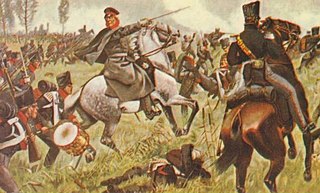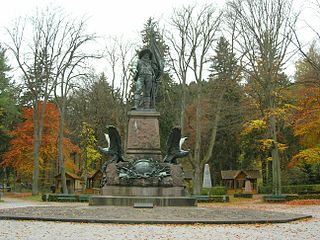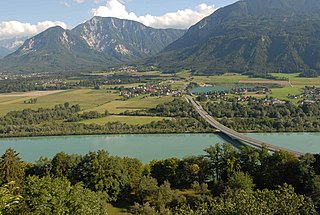This is the complete order of battle of the French and Third Coalition armies during the Battle of Austerlitz.

The Battle of Teugen-Hausen or the Battle of Thann was an engagement that occurred during the War of the Fifth Coalition, part of the Napoleonic Wars. The battle was fought on 19 April 1809 between the French III Corps led by Marshal Louis-Nicolas Davout and the Austrian III Armeekorps commanded by Prince Friedrich Franz Xaver of Hohenzollern-Hechingen. The French won a hard-fought victory over their opponents when the Austrians withdrew that evening. The site of the battle is a wooded height approximately halfway between the villages of Teugn and Hausen in Lower Bavaria, part of modern-day Germany.

The Battle of Wartenburg took place on 3 October 1813 between the French IV Corps commanded by General Henri Gatien Bertrand and the Allied Army of Silesia, principally the I Corps of General Ludwig von Yorck. The battle allowed the Army of Silesia to cross the Elbe, ultimately leading to the Battle of Leipzig.
This is an order of battle of the French and German Armies at the beginning of the Franco-Prussian War in 1870.

The Austro-Polish War or Polish-Austrian War was a part of the War of the Fifth Coalition in 1809. In this war, Polish forces of the Napoleon-allied Duchy of Warsaw and assisted by forces of the Kingdom of Saxony, fought against the Austrian Empire. In June, the Russian Empire joined against Austria. Polish troops withstood the Austrian attack on Warsaw defeating them at Raszyn, then abandoned Warsaw in order to reconquer parts of pre-partition Poland including Kraków and Lwów, forcing the Austrians to abandon Warsaw in futile pursuit.

In the Battle of Sankt Michael on 25 May 1809, Paul Grenier's French corps crushed Franz Jellacic's Austrian division at Sankt Michael in Obersteiermark, Austria. The action occurred after the initial French victories during the War of the Fifth Coalition, part of the Napoleonic Wars. Sankt Michael is located approximately 140 kilometers southwest of Vienna.

Caldiero 1805 order of battle

The Battle of Graz took place on 24–26 June 1809 between an Austrian corps commanded by Ignaz Gyulai and a French division led by Jean-Baptiste Broussier. The French were soon reinforced by a corps under Auguste Marmont. The battle is considered a French victory though Gyulai was successful in getting supplies to the Austrian garrison of Graz before the two French forces drove him away from the city. Graz, Austria is located 145 kilometers south-southwest of Vienna at the intersection of the modern A2 and A9 highways.

The Battle of Abensberg was fought on 20 April 1809, between an Allied force under the command of Emperor Napoleon I of France on one side and three Austrian corps led by Johann von Hiller, Archduke Louis of Austria, and Michael von Kienmayer. The Austrians formed the left wing of Archduke Charles, Duke of Teschen's main army and were under the overall command of Hiller. Napoleon's French troops, reinforced by troops from the Kingdom of Bavaria and the Kingdom of Württemberg outfought their opponents, inflicted heavy losses, and forced the Austrians to retreat to the southeast.

The Battle of Neumarkt-Sankt Veit on 24 April 1809 saw a Franco-Bavarian force led by Marshal Jean-Baptiste Bessières face an Austrian Empire army commanded by Johann von Hiller. Hiller's numerically superior force won a victory over the Allied troops, forcing Bessières to retreat to the west. Neumarkt-Sankt Veit is located ten kilometers north of Mühldorf and 33 kilometers southeast of Landshut in Bavaria.

At the beginning of the War of the Fifth Coalition on 9 April 1809, the armies of the Austrian Empire invaded the Kingdom of Bavaria, an ally of the First French Empire, and the Kingdom of Italy, a French satellite. After Austria's defeat in the War of the Third Coalition the County of Tyrol and the Vorarlberg were ceded to Bavaria in the Fourth Peace of Pressburg on 26 December 1805. Angry at the imposition of Bavarian laws and conscription, the Tyrolese rebelled in support of Austria. During the first week, local irregular forces killed or captured the main Bavarian garrison and also forced a French force to capitulate.
The Battle of Sacile saw the Franco-Italian Army of Italy commanded by Eugène de Beauharnais face the Archduke John of Austria's Army of Inner Austria during the War of the Fifth Coalition. Believing that he was only opposed by the Austrian VIII Armeekorps, Eugène launched his right wing in a heavy attack against it. In the morning, the Austrians successfully held off Franco-Italian assaults on their left flank as Eugène reinforced the attack with troops from his left wing. Later in the day, John counterattacked Eugène's weakened left wing with the IX Armeekorps, forcing the Franco-Italian army to withdraw from the battlefield. The battle at Sacile was preceded by the action of Pordenone on 15 April in which the Austrian advance guard mauled the French rear guard. The Austrian victory compelled Eugène to retreat to the Adige River at Verona where he gathered reinforcements and planned a counteroffensive.

The Dalmatian Campaign saw several battles fought between 30 April and 21 May 1809 by Auguste Marmont's First French Empire soldiers and Andreas von Stoichevich's Austrian Empire troops. The Austrians drove the French from their positions on the Zrmanja River at the end of April. But in mid-May, the French counterattack forced back the Austrians. The defenders offered stout resistance, but ultimately Marmont broke out of Dalmatia and joined Emperor Napoleon's army near Vienna with over 10,000 men. The campaign was fought during the War of the Fifth Coalition, part of the Napoleonic Wars. Dalmatia is part of the modern-day nation of Croatia.
The XI Corps of the Grande Armée was a French military unit that existed during the Napoleonic Wars. In 1812, the corps was formed for the invasion of Russia and placed under Marshal Pierre Augereau. It did not fight in any battles and instead served a collection point for reserves. In spring 1813, it was reorganized and placed under the command of Marshal Jacques MacDonald. The corps fought at Lützen, Bautzen, the Katzbach, Leipzig, and Hanau in 1813. Still under MacDonald, the unit fought at Bar-sur-Aube and several minor actions in 1814.
The Piave River 1809 order of battle shows the units and organization for the Franco-Italian and Austrian Empire armies that fought in the Battle of Piave River on 8 May 1809. Eugène de Beauharnais, the viceroy of the Kingdom of Italy defeated Archduke John of Austria. Eugène's Advance Guard crossed the river first and was assailed by Austrian cavalry and artillery. The French cavalry routed the opposing cavalry and captured 14 enemy guns. A lull followed as John arranged his infantry in a formidable defensive position. Meanwhile, Eugène struggled to pour reinforcements into the bridgehead as the Piave rose dangerously. In the afternoon, the viceroy sent Paul Grenier to drive back the Austrian left while Jacques MacDonald mounted an assault on the center. The attack succeeded in breaking the Austrian line and compelling John to order a retreat.
The VI Corps of the Grande Armée was a French military unit that existed during the Napoleonic Wars. It was formed at the Camp de Boulogne and assigned to Marshal Michel Ney. From 1805 to 1811, the VI Corps fought under Ney's command in the 1805 Austrian Campaign: War of the Third Coalition, Prussian Campaign of 1806 and Polish Campaign of 1807 of the War of the Fourth Coalition. General Jean Gabriel Marchand was in charge of the corps for a period when Ney went on leave. The VI Corps was revived in 1812 for the French invasion of Russia and placed under Marshal Laurent Gouvion Saint-Cyr. It consisted entirely of Bavarian soldiers at that time. During the disastrous retreat from Moscow, the corps was virtually destroyed. In 1813, during the War of the Sixth Coalition, it was rebuilt and reorganized with French troops. Marshal Auguste de Marmont took command of the corps and managed it until Napoleon's abdication in 1814. It took part in many battles including Dresden and Leipzig in 1813. During the War of the Seventh Coalition, General Georges Mouton commanded the VI Corps at the Battle of Waterloo.
The VII Corps of the Grande Armée was a French military unit that existed during the Napoleonic Wars. It was formed in 1805 and assigned to Marshal Pierre Augereau. From 1805 to 1807, Augereau led the VII Corps in the War of the Third Coalition and the War of the Fourth Coalition. It was disbanded after being nearly wiped out at the Battle of Eylau in February 1807 and its surviving troops were distributed to other corps.
The VIII Corps of the Grande Armée was a French military unit that existed during the Napoleonic Wars. Emperor Napoleon I formed it in 1805 by borrowing divisions from other corps and assigned it to Marshal Édouard Mortier. Marshal André Masséna's Army of Italy was also reorganized as the VIII Corps at the end of the 1805 campaign. The corps was reformed for the 1806 campaign under Mortier and spent the rest of the year mopping up Prussian garrisons in western Germany.

The Battle of Feistritz saw an Imperial French corps led by Paul Grenier attack an Austrian brigade under August von Vécsey. After putting up a stout resistance, the outnumbered Austrians were defeated and forced to retreat. The clash occurred during the War of the Sixth Coalition, part of the Napoleonic Wars. Feistritz im Rosental is located on the right bank of the Drava River near the southern border of Austria, about 16 kilometres (10 mi) southwest of Klagenfurt. At the time, it was located at the border with the French-controlled Illyrian Provinces to its west and south.
Paul von Radivojevich was an Austrian army corps commander in the army of the Austrian Empire during the late Napoleonic Wars. He joined the army of the Habsburg monarchy in 1782 and fought in one of the early battles of the French Revolutionary Wars. He led a Grenz Infantry Regiment before being promoted to general officer in 1807. He led a brigade at Eckmühl in 1809, a division in the summer of 1813, and a corps at Caldiero in 1813 and at the Mincio in 1814. During the 1815 Italian campaign, he led a corps in Switzerland, Piedmont, and France. After the wars, he commanded part of the Military Frontier. He was Proprietor (Inhaber) of an infantry regiment from 1815 until his death in 1829.









